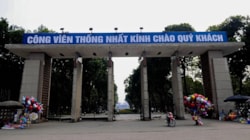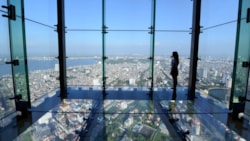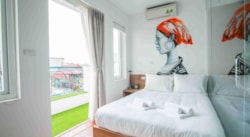1. Where is the Presidential Palace?
The overall relic area is more than 14 hectares wide, of which the area is classified as 22,000 m², including 16 large and small works, of which, the highlight is Uncle Ho's Stilt House. The Presidential Palace is located at 01 Hoang Hoa Tham Street, Ba Dinh district, Hanoi. The main entrance leading to this place is painted with an astonishing red color. It’s on the first corner of Ngoc Ha Street, one of the most notable streets in Ba Dinh district.
It is easy to find the direct routes that lead to this amazing historical site in Hanoi. Google Maps is reasonable and yet recommended to search for the location of the Presidential Palace.
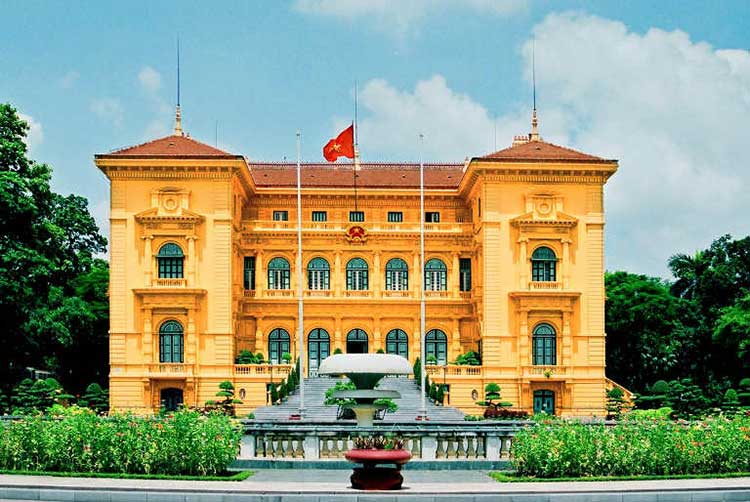
Presidential Palace’s front side in the morning
2. Why is the Presidential Palace worth a visit?
Designed and completed by architect Auguste Henri Vildieu in 1906, the splendid Presidential Palace was originally built for the Governor General of Indochina. After the French colonialists withdrew from Vietnam in 1954, revolutionary leader Ho Chi Minh lived in this place until his death a few years later.
The Presidential Palace has been nominated as one of the 23 most notable relics of Hanoi City by the Vietnamese Prime Minister's Office due to the fact that President Ho Chi Minh had lived here for almost 15 years consecutively.
2.1. The Presidential Palace has a beautiful architecture
This historical site has a tremendous collection of many distinctive constructions that reflect the life in the past of President Ho Chi Minh, such as:
-
Wooden stilt house
This is considered a special office of Uncle Ho from 1958 - 1969 as the President of the Democratic Republic of Vietnam when the financial situation in Northern Vietnam was worse due to many bombing raids of the US Air Force (USAF) from 1963 - 1972.
Ho Chi Minh's stilt house brings the beauty of the stilt house architecture of Tay and Thai ethnic groups in Viet Bac in accordance with Uncle Ho's wishes. The house is made of wood, tiled roof, has a widespread outdoor site, 2-storey structure.
Later in 1969, after President Ho Chi Minh's death, the Communist Party and the government created a policy of preserving the artifacts of Ho Chi Minh's Stilt House and had another stilt house restored according to the prototype for everyone to visit. The task of sealing and preserving has been carried out meticulously and carefully by military engineers for 2 years, following the same sealing process as with supplies and weapons in the military warehouse.

Ho Chi Minh’s Stilt House - an iconic and notable architectural structure of the Presidential Palace
-
Uncle Ho’s Fish pond
A fundamental yet nostalgic construction to remind us about our beloved Uncle Ho during his lifetime at the Presidential Palace. At first, the fishpond was somehow abandoned for years after the French retreated from Hanoi around 1944 - 1945. Lots of wild water lilies and other flora have been nurtured to grow at this pond so back then it looked like a massive jungle here. President Ho Chi Minh by then ordered some of his guards to renovate it and raise some of the most economic species of fish as a policy of economy back in the 1950s.
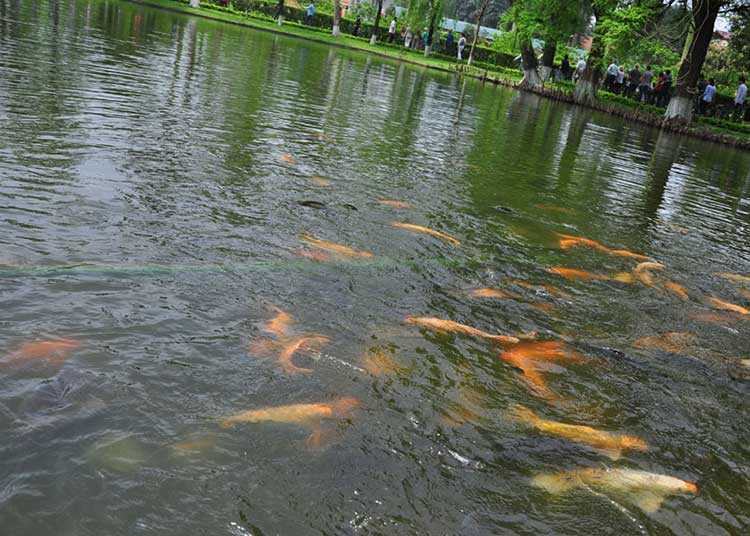
Tourists can spend a day walking around the pond to relax and enjoy the path that President Ho Chi Minh used to walk during his break time many decades ago.
-
Mango Street
A street where tourists can smell the fragrance of mango fruits along the path. These mango trees were once favored by President Ho Chi Minh and were planted more than 50 years ago. Nowadays, they have grown big and still act as an iconic “artifact” of the Presidential Palace, where Uncle Ho lived and worked during his last 15 years before passing away in the autumn of 1969. Nowadays, this mango street still has its unique and tropical smell of fruits as it always had more than half a century ago. However, tourists are not allowed to pick any mango fruit from any mango tree on this street due to the fact that the government want to keep it intact.
-
House No. 54
In December 1954, President Ho Chi Minh returned to work at the Presidential Palace. However, Uncle Ho did not like to live in the house used as the Presidential Palace, which was formerly the building of the old Governor General of Indochina but decided to live in the house of the electrician who served the Governor General. Judging from the year Uncle Ho began to rest and work, the Presidential Palace Relics Management Board called this relic house 54. Uncle Ho lived and worked here from December 19, 1954, to May 17, 1958. After this time, Uncle moved to the house on stilts. However, every day Uncle Ho has a daily health check at this place, bathing, eating and then welcoming guests, especially foreign reporters and politicians from everywhere.
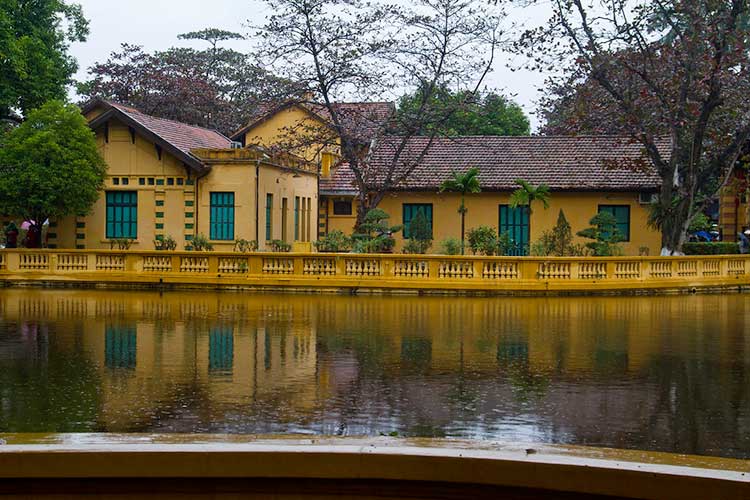
House No.54
During his time in House 54, President Ho Chi Minh, along with the Party Central Committee and Politburo, built guidelines and strategies for the resistance war of the Vietnamese army and people to liberate the South, unify the country, as well as The North's construction and economic development plans aim to build the first facilities for the country's construction.
House 54 has three rooms. The room adjacent to the fish pond is the office and also the place Uncle used to receive guests. In the middle is the dining room and finally the bedroom. Currently, in the ruins of house 54, all of Uncle Ho's daily utensils are still kept. The documents, books and newspapers that Uncle Ho was reading as well as the souvenirs given to President Ho Chi Minh by international friends are still preserved and classified. Neatly placed like when Uncle was still alive.
-
House No. 67
At the Presidential Palace, located modestly behind the Stilt House is a one-story house with a flat roof covered in light green coating called House 67. This house has walls with more than 60 cm thick and ceilings more than 1 m thick are all made of reinforced concrete, ensuring solidity, and solidity but still airy and convenient for living.
However, Uncle Ho did not accept the house for himself but decided to use House No. 67 as a meeting place for the Communist party and a place to work with his comrades in the Central Committee as well as leading officials in charge of the industry to discuss important issues. importance of the country.
At this house, President Ho Chi Minh also wrote many books and memoirs about the devastation of wartime from 1967 until his death 2 years later, especially his famous replying letter to President Richard Nixon to declare and announce the faithful belief in the final victory of the Vietnam War of the people.
2.2. A special place with a meaningful historical story
This historical site has always been one of the most notable and famous destinations in the Ba Dinh district, along with the Ba Dinh Mausoleum where the body of President Ho Chi Minh has been lied. The Presidential Palace has been a place of magnificent stories about Uncle Ho during his stay in House No. 54 and then No. 67 when the Stilt House was not fully completed yet.
Additionally, Mr. Vu Ky, one of the most trusted secretaries of President Ho Chi Minh back in the 60s, said that his service in the Presidential Palace at that time was tremendous and memorable when USAF was bombing Hanoi for almost a decade (1963 - 1972) and it was finally ended with the victory of Linebacker II operation on December 1972.
3. Presidential Palace opening hours and entrance fee
The Presidential Palace is open for visitors from 8 AM to 4:30 PM on every day of the week. However, the opening hours in summer will be different from the one in winter which is sooner 30 minutes exactly. Local visitors or Vietnamese visitors are free of charge but unfortunately, the entrance fee will be 40.000 VND for each person and the ticket will expire at the end of the day.
>>> Read more: Best places to visit near Hanoi
4. When is the best time to visit the Presidential Palace?
Spring and autumn are the best options for tourists to visit this interesting historical site in Hanoi. This is because the climate of Northern Vietnam is a bit different from the Southern one literally. Besides, during autumn there are many festivals that tourists can enjoy or even participate in with a joyful and relaxing experience.
5. How to get there?
There are some bus routes that lead directly to the Presidential Palace in no time. Although tourists have to catch the right one in order to get there, buses are safe and convenient enough for everyone to enjoy the trip fully. Taxis are also another good choice but you have to be aware of the conglomerate, which is mostly fixed by some drivers to tip you off. We recommend that renting a motorbike is an ideal way to get to the Presidential Palace. It will cost you only around 120.000 - 150.000 VND a day and a parking space in the parking lot. However, a motorbike will be much more versatile than any transportation service like Grab or Gojek.

There are some bus routes that lead directly to the Presidential Palace in no time
6. Extra tips
Near the Presidential Palace are located many food vendors and food stalls so that visitors can buy something for lunch or brunch such as Pho, spring rolls, etc., and some delicious beverages, too. A parking lot nearby is very secure to park your rented vehicles like motorbikes for example. It costs only around 4000 - 5000 VND for each motorbike.
Do not touch any artifact or relic that is not allowed and follow all of the instructions carefully. Ask your tour guide for everything you need to know during your visit and make sure that you understand what he said properly. Souvenirs are placed and sold in a sector near the Presidential Palace with various choices for you to decide like a conical hat or a miniature of Uncle Ho.

